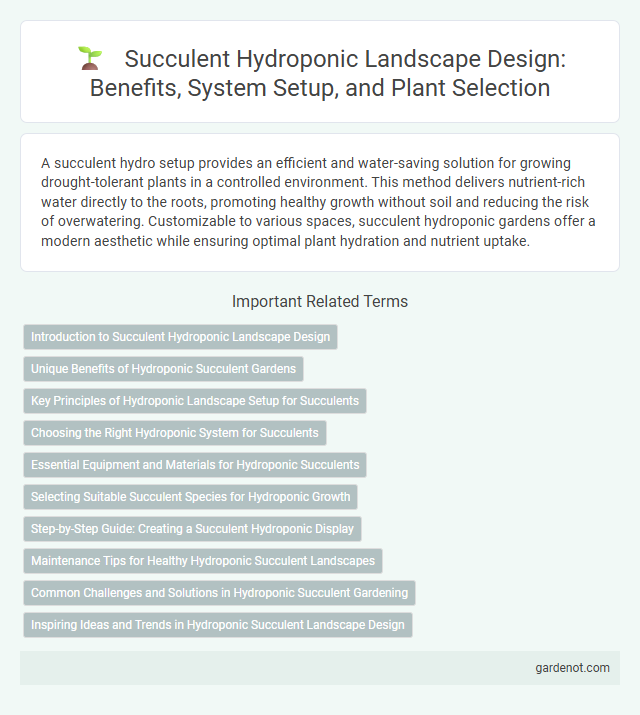A succulent hydro setup provides an efficient and water-saving solution for growing drought-tolerant plants in a controlled environment. This method delivers nutrient-rich water directly to the roots, promoting healthy growth without soil and reducing the risk of overwatering. Customizable to various spaces, succulent hydroponic gardens offer a modern aesthetic while ensuring optimal plant hydration and nutrient uptake.
Introduction to Succulent Hydroponic Landscape Design
Succulent hydroponic landscape design combines the water-efficient growth of succulents with soil-free hydroponic systems, optimizing space and water usage for modern gardening. This method leverages nutrient-rich water solutions and precise environmental controls to promote robust root development and vibrant foliage, creating low-maintenance, aesthetically pleasing green spaces. Succulent hydro setups are ideal for both indoor and outdoor environments, enhancing air quality while minimizing resource consumption.
Unique Benefits of Hydroponic Succulent Gardens
Hydroponic succulent gardens offer remarkable water efficiency by delivering nutrient-rich solutions directly to the plant roots, reducing water waste by up to 90% compared to traditional soil methods. These systems promote faster growth cycles and healthier succulents due to precise control over nutrient levels and pH balance. Space-saving design and minimal maintenance needs make hydroponic setups ideal for urban environments and small-scale gardening enthusiasts.
Key Principles of Hydroponic Landscape Setup for Succulents
Succulents thrive in hydroponic landscape setups when provided with well-draining, aerated nutrient solutions that mimic their natural arid environments. Maintaining controlled moisture levels and ensuring adequate light exposure are key principles to prevent root rot and promote optimal growth. Using inert growing media like perlite or clay pellets supports root stability while facilitating efficient water and nutrient uptake.
Choosing the Right Hydroponic System for Succulents
Selecting the appropriate hydroponic system for succulents requires considering their low water requirements and preference for well-aerated environments. Nutrient Film Technique (NFT) and semi-hydroponic setups with inert substrates like LECA or perlite provide optimal drainage and oxygenation for succulent roots. Ensuring precise control over moisture levels prevents root rot, promoting healthy growth and vibrant foliage.
Essential Equipment and Materials for Hydroponic Succulents
Hydroponic succulent setups require essential equipment such as a water reservoir, submersible pump, and aeration system to maintain optimal oxygen levels for root health. Inert growing mediums like expanded clay pellets or perlite provide proper support and drainage, preventing root rot while promoting moisture retention. Nutrient solutions formulated for succulents must offer balanced macro and micronutrients to ensure healthy growth in a soilless environment.
Selecting Suitable Succulent Species for Hydroponic Growth
Selecting suitable succulent species for hydroponic growth involves prioritizing varieties with low water requirements and tolerance to high humidity, such as Haworthia, Echeveria, and Sedum. These species thrive in well-aerated nutrient solutions and adapt well to hydroponic setups due to their compact root systems and resistance to root rot. Optimizing nutrient concentration and pH levels between 5.5 and 6.5 enhances growth and maintains the succulents' structural integrity in hydroponic environments.
Step-by-Step Guide: Creating a Succulent Hydroponic Display
Begin by selecting a shallow hydroponic container and filling it with a nutrient-rich water solution tailored for succulents. Arrange succulent cuttings or small plants carefully, ensuring their roots are submerged while allowing airflow to prevent rot. Maintain optimal lighting and monitor water quality regularly to promote healthy growth and vibrant display longevity.
Maintenance Tips for Healthy Hydroponic Succulent Landscapes
Maintaining a healthy hydroponic succulent landscape requires monitoring water quality and ensuring proper nutrient balance, as succulents thrive on minimal but consistent moisture. Regularly check pH levels to stay between 5.5 and 6.5, and avoid overwatering to prevent root rot by allowing the growing medium to dry slightly between nutrient cycles. Cleaning the hydro setup components and providing adequate light exposure will further promote robust growth and vibrant succulents.
Common Challenges and Solutions in Hydroponic Succulent Gardening
Hydroponic succulent gardening often faces challenges such as root rot caused by overwatering and poor drainage, leading to oxygen deprivation in the root zone. Solutions include using well-aerated substrates like expanded clay pellets and maintaining a controlled watering schedule to prevent excess moisture accumulation. Monitoring pH levels between 5.5 and 6.5 alongside providing ample light intensity around 10,000 lux helps optimize succulent growth in hydro setups.
Inspiring Ideas and Trends in Hydroponic Succulent Landscape Design
Innovative hydroponic succulent landscape designs embrace minimalistic containers with self-watering systems that optimize water efficiency and root aeration. Trendsetting setups utilize LED grow lights tailored to succulent light requirements, enhancing growth while conserving energy. Incorporating diverse succulent species with varying textures and colors creates a visually dynamic, low-maintenance hydroponic garden ideal for urban spaces.
Succulent hydro setup Infographic

 gardenot.com
gardenot.com